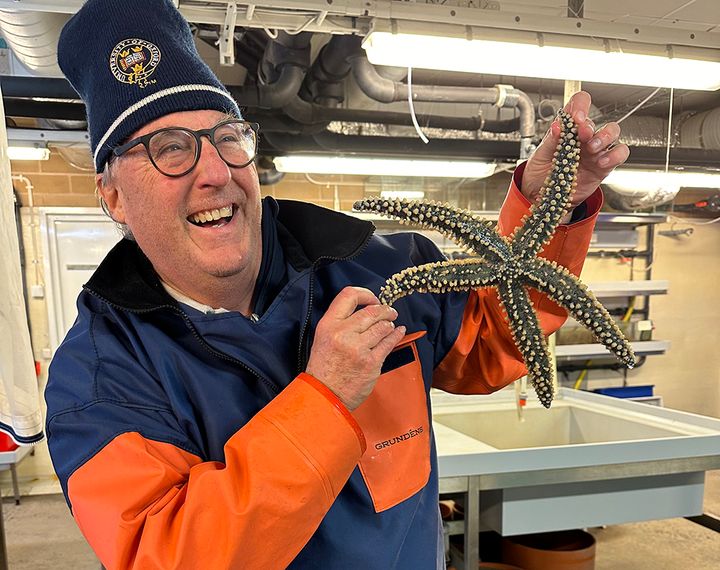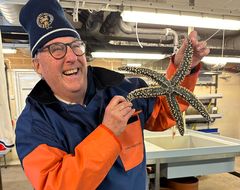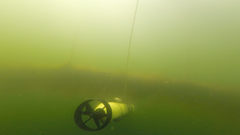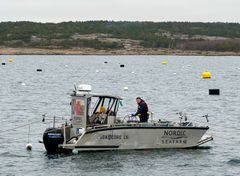To compete globally, Europe’s seafood farmers may get boost from AI research
Underwater drones adapted to cold Nordic waters, and sensors that listen to the sounds of fish eating. These are some of the AI solutions that could give European sea farmers a boost to compete globally. Researcher Fredrik Gröndahl explains how maching learning is being developed take on operational challenges and reduce costs in aquaculture, particularly in inaccessible waters far offshore.

In the global seafood market, European aquaculture could expect a boost from AI solutions developed by researchers at KTH Royal Institute of Technology in Stockholm.
At the Blue Food research centre KTH researcher Fredrik Gröndahl oversees several projects that harness machine learning to take on operational challenges and reduce costs in aquaculture, particularly in inaccessible waters far offshore.
Seafood farmers incur high costs in hiring the vessels and divers needed to access seaweed beds, which are increasingly being located farther from shore in order to avoid conflict with other coastline uses and property rights.
So researchers at KTH have been working on substituting boats and divers with underwater drones (autonomous underwater vehicles) that are to be optimized for the colder Nordic waters. These vessels, which are under development at the Swedish Maritime Robotics Centre at KTH, are equipped with sonar and algorithms to detect the submerged ropes that seaweeds grow on. Enabled by artificial intelligence they are meant to navigate along these lines, well out of view of their human operators on land.
Savings for fish farmers
AI is also being adapted to fish farming. In the oyster beds of Sweden’s west coast, the Skagerrak strait, Blue Food researchers are testing algorithms intended to identify invasive species of oysters from those approved for cultivation in the EU.
The research attracts investment because it offers a realistic way to level the playing field in competition with large-scale sea farming, particularly in China, he says.
“I visited a giant seaweed farm in China that had 1,000 hectares of seaweed alone, plus mussels and other fish,” Gröndahl says. “They were very labour intensive, with the work being done mostly by hand. We could never do that in Sweden.
“Labour in Europe is expensive so we have to have machines and automated, optimized systems to be competitive to produce food,” he says.
Machine learning is also being developed to avoid wasting fish feed in enclosed pens. With the help of submerged microphones, the researchers are testing an automated feeding system that listens for the sounds of fish eating. When the sounds subside, the release of feed is shut off. “This can save a huge amount of money for fish farmers, on land or in the sea,” he says.
“You can optimize the feeding so the fish get exactly what they need. Otherwise, if the fish are full the excess feed will sink to the bottom and then we have a problem,” Gröndahl says.
On land, AI also can be used for balance and control of water quality to prevent anoxic death of fish being raised in enclosed systems.
Synergies with energy sector
The work also enables synergies with the energy sector, where interest is growing in combining offshore wind parks with seaweed farming. In these kinds of scenarios, sea drones can also be used for more continuous monitoring of windmill and wave energy, which take a beating in the harsh conditions of the ocean.
“We are trying to find ways to be more and more competitive,” he says. “Around Europe, whenever we present this underwater robot collaboration, people get very enthusiastic.”
Contacts
Fredrik GröndahlBlue Food Seafood CentreKTH Royal Institute of Technology
Fredrik Gröndahl is the Director of the Blue Food Seafood Centre and a researcher at KTH Royal Institute of Technology in Stockholm, Sweden.
Images




Subscribe to releases from KTH Royal Institute of Technology
Subscribe to all the latest releases from KTH Royal Institute of Technology by registering your e-mail address below. You can unsubscribe at any time.
Latest releases from KTH Royal Institute of Technology
For graphene production, a potential green alternative to mining graphite3.3.2025 14:14:40 CET | Press Release
Researchers in Sweden report a green alternative to reduce reliance on mining graphite, the raw source behind the "wonder material" graphene.
AI on aircraft can help prevent stalls and terrifying drops in altitude17.2.2025 15:58:14 CET | Press Release
Artificial intelligence could help prevent terrifying mid-air drops in altitude. In a new study, an international research team successfully tested a machine learning system for preventing trouble with turbulence.
Alternative to studded winter tires reduces airborne particles by 20 percent6.2.2025 14:41:07 CET | Press Release
On icy roads, studded winter tires can save lives – but they pulverize pavement and fill the air with dangerous, inhalable particles. A new Swedish study shows that both road wear and airborne particles could be reduced by as much as 20 percent if studs were made instead with an alternative hard metal.
As Scandinavian peninsula rises from sea, new satellite data shows gravity changes6.2.2025 09:15:25 CET | Press Release
Bouncing back from under the weight of Ice Age glaciers which have long since vanished, the Nordic region land mass is slowly rising above sea level. Two scientists at Sweden’s KTH Royal Institute of Technology have a refined a method for measuring and predicting the small details of how this slow movement changes Earth’s gravitational pull over time. One thing they found is that the Fennoscandinavian peninsula's land mass is more dense than previously known.
Study on ship sliming may enable reduced costs and emissions in ocean transport21.1.2025 11:25:01 CET | Press Release
Slime build-up is a costly drag on fuel efficiency for ocean-going cargo ships, leading to more emissions and, eventually, higher consumer prices. A recent study, however, suggests a new approach to managing this common problem.
In our pressroom you can read all our latest releases, find our press contacts, images, documents and other relevant information about us.
Visit our pressroom